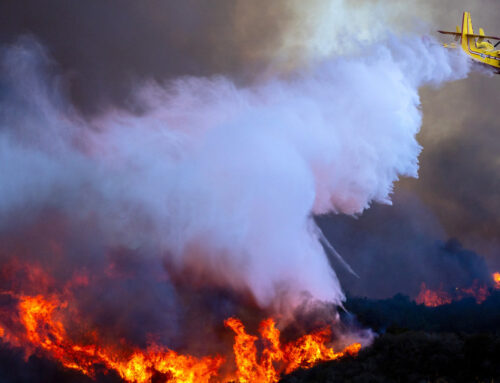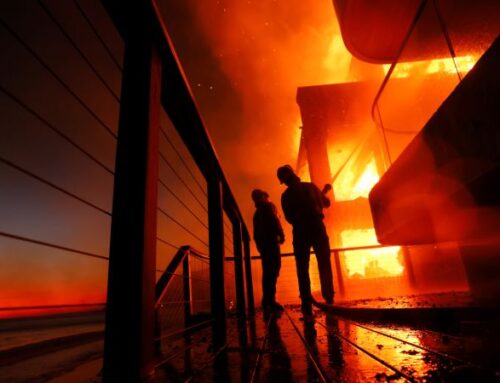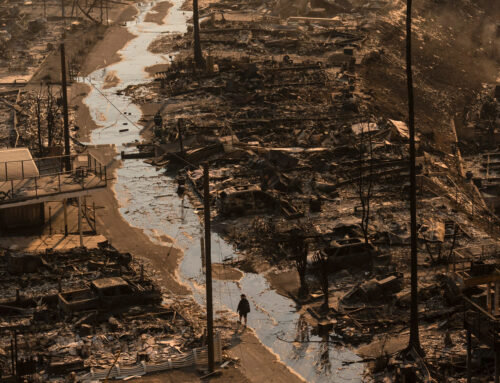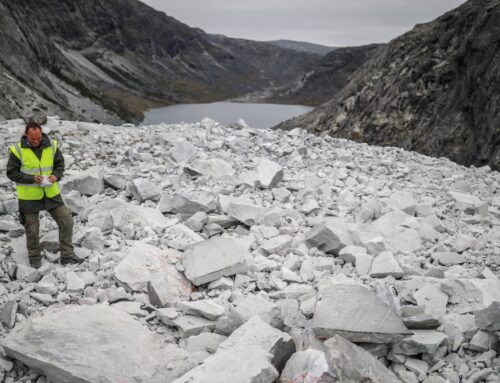Uninsurable Futures
January 14, 2025
Over the past two years I wrote several essays about what is likely to happen when climate change precipitates a crisis in the American home insurance market. In essence, I argued that climate change will make insurance unaffordable in large, at-risk swaths of the nation, which will create pressure on politicians in those areas, who, rather than allowing private insurance companies to accurately price risk, will take increasingly desperate measures to hide the crisis in state-run “insurers of last resort” which cannot possibly pay the costs associated with the serious disasters that will occur more and more frequently as climate change proceeds. This, in turn, will cause state and local politicians to run to the federal government for bailouts after expensive climate-related disasters, which will soon produce a political backlash from states less affected by climate disasters, who will chafe at the demands to pay the spiraling costs of rebuilding the homes of those who live in harm’s way. In this way, insurance can become the “tip of the spear” that forces our nation to confront the grim choices that climate change demands, though the path to reaching this reckoning will almost certainly be the most excruciating one possible. Our leaders will make the hard but necessary decisions only after exhausting every other possibility.
Predicting this scenario does not require any particular expertise in insurance underwriting or climatology. It requires only 1) acceptance of the reality of climate change, 2) basic math, and 3) an understanding of how American politicians operate.
The estimates for the direct cost of the Los Angeles fires, which are still burning, range from $20 billion to $50 billion, though California’s governor says they may end up being the most expensive disaster in US history when the full damages are tallied. Six of the ten most expensive wildland fires in American history happened in the past decade, and six of the ten most expensive disasters in American history (most of them storms) happened in the past decade as well. Those records are sure to become even more lopsided in the near future. Globally, disasters caused $320 billion in damages in 2024, a third higher than in 2023. The year that just ended was the hottest one on record. That is another record that won’t last long. The world has exceeded the 1.5-degree level of warming above preindustrial levels that was once viewed as a hard limit by climate activists. News of that failure came at the same time that CEOs of America’s most powerful finance companies were busy announcing that they are withdrawing from the UN climate coalition they all rushed to join when joining was viewed as something that came with political benefits. From LA to Wall Street, everybody is watching which way the winds are blowing.
The scenario of a state-run insurance plan going broke due to a big disaster has now come true. California’s state-run insurer, the FAIR Plan, reportedly had less than $3 billion in combined cash and reinsurance on hand, yet is going to be on the hook for billions of dollars more in claims from these fires. The scenario of a nasty intrastate political war over insurance payouts is also coming true. In the past few days, multiple Republican Senators have said that they intend to put conditions on federal relief money for California, using the disaster as a naked piece of political leverage for unrelated policy goals. The two Republican Senators who pushed back on these conditions are from Florida and North Carolina, states that recently experienced devastating storms. This hints at the inevitable political realignment that will drive a wedge between states more and less exposed to climate damage. Mother Nature is more powerful than MAGA. The only question is how long red state Republicans will cling to their insane ideology of gleeful denial before they are battered into submission by their own burned out, flooded, displaced constituents.
It is too early to know what will be left of Los Angeles when the fires subside. But it is not too early to think about the consequences that will ripple out afterwards. We are approaching the end of the era when the only response to a natural disaster is “to rebuild.” The Pacific Palisades and other fire-prone neighborhoods are never going to be what they were again. Not least because their already high insurance rates are going to rise again, far past the point of economic rationality. Private insurers will not operate in markets where they cannot make money. Therefore all future insurance in the riskiest markets will be stupidly expensive, nonexistent, or provided by the state. The very rich can, if they want, rebuild their mansions in the same places and take their chances. Everyone else will either be pushed out to safer areas by the uninsurability of their old neighborhoods, or will busy themselves lobbying the government to subsidize rebuilding in those old neighborhoods with fictitiously affordable insurance rates—a move that will only kick the can of managed retreat down the road at fantastic public expense.
There is no “good news” when a city and its homes burn. There is, however, an opportunity that will be offered to all of us in turn after we experience our own disasters: the chance to remake the way we live with sustainability in mind. We don’t know where the next wildfire or hurricane will strike, but we do know these things: In coming decades, the habitable zone of America will move north; great swaths of the deep South and the Southwest will become so hot that the population influx they have gotten with their cheap housing is sure to reverse itself; dangerous “wet bulb” temperatures will grip the Gulf Coast, bigger and bigger wildfires will sweep parts of the West, and rising sea levels will flood parts of the East Coast. All of these things, you can be sure, are happening, and will happen with slowly increasing severity. We can either adapt to them in panicked fits and starts, disaster by disaster, hanging onto an outdated vision of American life until reality punishes us badly enough to give it up; or, we can get to work adapting to them intelligently now, which could spare millions of people from having to absorb the disasters themselves, and save us trillions of dollars in the process. That money can build our future, rather than constantly rebuilding our past and watching it be shattered over and over again.
There is the long term project of cobbling together a political coalition that will actually deal with climate change like adults, which is vital but can seem impossible to accomplish. And there are the short term projects of disaster response—new building materials, more firefighters, more clearing of brush, whatever—that occupy public attention because they are achievable, but which will not really change the long term trajectory of what is coming. Between these two extremes, though, there are serious political goals that we can throw ourselves into that have enormous impacts on how painful the process of climate adaptation will turn out to be. Take housing, for example. Los Angeles, already mired in an affordable housing crisis because of a dire lack of housing supply, now faces tens of thousands of people forced out of destroyed neighborhoods will must all try to secure new housing at once. The rich will snap up everything on the market. Prices will get bid up and rents will rise for everyone. We will see, with vivid suffering, the consequences of having a city that stubbornly maintains 72% of its space as single-family zoning, despite great demand for new housing. All of the Los Angeles homeowners who have lobbied against adding density in their own neighborhoods have helped to cause the city’s current housing crisis, but those on the losing end of the high prices have been invisible inside of the single-family neighborhoods. Now, the city is full of overnight refugees. The lack of available housing is on display everywhere. NIMBYism is less socially acceptable when its consequences are embodied in your own friends and colleagues who have lost their homes and are faced with no more homes to move into.
The future is sustainability. The future is density. The future is managed retreat away from flood zones and wildfire zones, and the movement of all of those people into denser, more compact, urbanized, sustainable neighborhoods. That means more mass transit and fewer cars. More bike lanes and fewer highways. More apartment buildings and fewer lawns.
For Americans, the hardest part of what is coming is going to be giving up on the grand American myth of infinite material abundance. The classic vision of the American dream—the house, the yard, the driveway with a big car for everyone—is going to have to go away, by necessity. It will not go quietly. Americans regard these things not as temporary byproducts of a particular age of global capitalism that cannot last, but rather as human rights. Much of the confounding Trumpian tendency to celebrate big trucks and more oil drilling and other things we know are bad for us is simply a child’s gut reaction to being told that we cannot have that lollipop, after all. Politically speaking, we are in the tantrum phase of the climate transition. This is understandable, on an emotional level; the sweet promise of abundance has long been the thing that soothed the public’s disgust with inequality. But we can’t allow ourselves to linger in this period. The longer we wallow in resentment and denial, the longer we put off the hard work of adaptation, and the more difficult and costly the adaptation becomes. Every time you see a politician telling voters they can damn well have a big McMansion with icy air conditioning and a Ford F-450 and cheap gas and a new highway to reach their new suburban development, take a moment to imagine how those voters will feel when the AC bills skyrocket, and the gas prices soar, and the heat kills the grass, and the overloaded electrical grid flickers, and the defunded public services mean that there is no one to come save them when the trees catch fire. We are not doing anyone any favors by denying reality.
It is odd, the experience of seeing a long-predicted calamity begin to unfold. It has a surreal quality that can be paralyzing. The insurance prices go up and up until they explode like fireworks over burning Los Angeles and flooded Asheville. For all the uncertainty that grips us, one thing is certain: The crisis isn’t coming. It’s here.
-
Related reading: Insurance Politics at the End of the World; The Insurance Apocalypse Conversation America Won’t Have; The Five Mostly Disastrous Paths Through Our National Insurance Crisis; Bad Climate Socialism.
-
There is a ton of relief work being done in Los Angeles right now. For those who want to make donations to help the city recover, two places I can recommend are the Mutual Aid Los Angeles Network, and the California Teachers Association disaster relief fund. If you have other good charities to highlight, please drop them in the comment section below.
-
Thank you for reading How Things Work. This publication is as independent as it is possible to be. I am able to publish this site—and keep it paywall-free, so that anyone can read it regardless of income—thanks to the support of readers like you who choose to become paid subscribers. If you enjoy reading How Things Work and would like to help it survive in an age when the traditional media industry is rapidly collapsing, take a moment to become a paid subscriber right now. For the price of dinner, you can read this site all damn year long. Not a bad deal.
Search
RECENT PRESS RELEASES
Related Post






